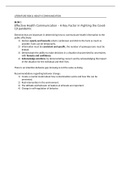Samenvatting
Summary ALL articles for part 1 of Risk and Health Communication
- Instelling
- Vrije Universiteit Amsterdam (VU)
ALL articles for part 1 of Risk and Health Communication summarized in one document, ready for you :) College 1: Fincet, A., et al. (2020). Effective health communication –a key factor in fighting the COVID-19 pandemic. Editorial Patient Education and Counseling, 103, : 10.1016/.2020.03.027...
[Meer zien]




